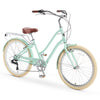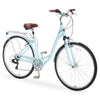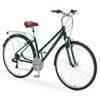Anatomy Of A Bicycle
Copy Link
http://www.sixthreezero.com/blogs/bike-advice/anatomy-of-a-bicycle

You know how to handle your bike around a tight corner and the number of pedals from your front door to the local park – but are you well acquainted with what makes your bike tick? A thorough understanding of how your bike operates helps you maintain it. Everything from the anatomy of a bicycle wheel to the inner workings of your chain will empower you to take better care of your bike. Here are some of the most important parts:
Saddle: The seat of your bike is also called the saddle. The physics of your saddle will depend largely on the type of bike you have. On racing bikes, the seat will be narrow and have light padding. A comfort bike will have a saddle with more padding and a wider seat.
Seatpost: A seatpost is usually made from aluminum, titanium, or steel, and it connects your saddle to the frame of your bike. Some seatposts are adjustable so you can change the distance between the seat and the crossbar based on your needs.
Frame: This is the largest part of your bike, and it’s made up of more than a dozen smaller bits. The parts of a bike frame include the top tube, which makes up the top part of the bike, the dropouts where the wheels attach, and the disc tabs where the disc brake caliper fits.
Brakes: All bikes have brakes (thank goodness), but the type depends on the ways the bike is used. The four types are caliper, cantilever, linear pull (V-brakes), and disc brakes. Caliper brakes mount on a single post and are often used on road bikes, while cantilever and linear pull brakes attach at multiple posts and are found on mountain and hybrid bikes. A lot of bikes have disc brakes, which attach near the bottom of the frame.
Wheels: Your bike wheels are made up of the hub, rim, and spokes. The most important factor when selecting wheels is the size and the type of tire.
Derailleurs: Every bike has two of these components: a front and a rear. This is a fancy word for a mechanism that moves your chain from cog to cog on the front and guides the chain from ring to ring in the rear.
Crankset: A crankset has arms and rings and serves as a sort of transmission for your bicycle. It turns the energy from your legs and puts it into the pedaling system. An efficient crankset will help you avoid wasting energy while you ride.
Knowing about your bicycle components makes you a smarter biker who can better care for your two-wheeled chariot. When your bike stays in great condition it has a longer lifespan and works at maximum potential. Need a new ride? Check out our bikes for work commute or sixthreezero Around the Block Women’s 26" 3-Speed today.
Do you want to find new and exciting places to take your bike on an adventure? Sixthreezero is here to help. Join our Journey Club to uncover new and thrilling ride locations around the globe for all types of cyclists.
Take our Free Body Fit Questionnaire

Similar Articles
If you fall outside the average measurements of most folks, you know that sizing items are...
Getting started when biking uphill, it's going to be hard when you start off, especially if...
Now that spring is here, it's sunny, you definitely want to get that vitamin D and...
















